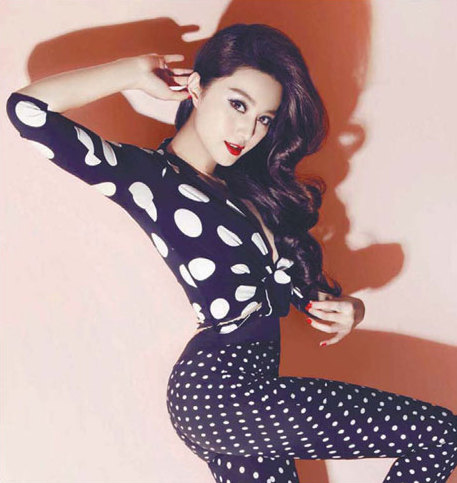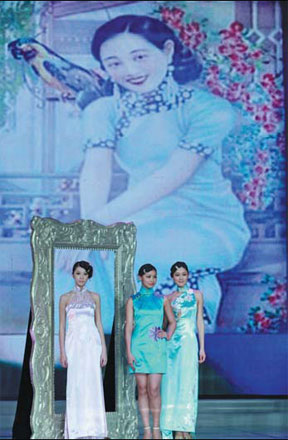Good hair days
Updated: 2013-04-12 07:40
By Zhang Lei (China Daily)
|
||||||||
|
Chinese actress Fan Bingbing loves wearing wavy locks of hair that were fashionable in the 1930s. Photos provided to China Daily |
Women's hairstyles have long reflected social change in China, from feminine cuts influenced by Western movies to short boyish styles chosen as a symbol of equality
Imagine a woman in a traditional Chinese silk dress, with a slender waist and curvy figure, a chipper smile on her rosy cheeks, and long wavy locks of hair tumbling over her shoulders. Sauce it up with a little je ne sais quoi look in her eyes, or a flirtatious wink and you have the ideal Chinese woman of the 1930s, according to the fashion of the day.
"Early 20th century Shanghai was a melting pot of Western and oriental aesthetics. At that time women were heavily influenced by Western makeup. Hairstyles were mostly based on European classical portraits and fashion trends in the West," says Liu Mengtian, a researcher at the China Traditional Culture Association.
Although imported from the West, the Chinese blended these hairstyles seamlessly into the oriental look.
The most common look for fashionable women in the 1930s was wavy hair with a side parting, straight at the roots, with curls at the end to create a feeling of volume. Some women would tie the curls around their head to create a sophisticated look.
"Hair fashion was also heavily influenced by Hollywood. The 1930s witnessed a boom in Chinese adaptations of Western movies," Liu says.
Among the most influential actresses of the time in terms of hair fashion was Ruan Lingyu, whose curly locks appeared in 29 movies and encouraged scores of Chinese women to import Western elements into their appearance.
Finger waves and pin curves were used to frame the face, or softer, wavier styles to create feminine charm. Shorter styles were in fashion, parted in the middle or on one side and often topped with a short-brimmed hat.
"During this time, women treated their hairstyle as a crown and a symbol of the tender sex," Liu says.
|
The image on the screen is a typical fashionable woman in Shanghai in the 1930s. Photos provided to China Daily |
Models with the latest hairstyles wearing silk dresses were the pin-ups of their day, adorning postcards, calendars and magazines. Some of the earliest Chinese posters were of fashionable Shanghai women with Western hairstyles.
This wavy hairstyle of the 1930s saw a regained popularity in the 1980s when China began opening up to the outside world.
"The big waves can go with virtually any clothes, whether you want to hang out with friends or attend a formal party," Liu says.
Before the introduction of China's opening-up policy in 1978, this type of hairstyle was shunned as a symbol of the petty bourgeoisie. Women's hairstyles were more sober and children and young girls almost all wore pigtails. Pigtails were also common among young women as a symbol that they were not married, Liu says.
"An unmarried woman would often wear two long pigtails on either side of the head. This look was most prevalent in rural areas. Town girls preferred bunches, also called angel wings with their hair parted down the middle and gathered into two symmetrical bundles."
Married women wore ponytails with their hair pulled away from the face and secured with a clip at the back of the head.
At the beginning of the 1950s feminine hairstyles were shunned completely, with many women opting for boyish cuts as a reflection of equality between men and women.
"The hairstyle was similar to the English page boy hairstyle that has straight hair hanging to below the ear with a bang in the forehead. This style lasted almost two decades," Liu says.
In the late 1980s, Western hair salons began to appear in the Chinese mainland.
Hong Kong movies were also allowed on the mainland and began to influence hairstyles. Long hair came into fashion, unlayered, wavy and commonly parted on one side. This shoulder-length style was soft and resembled the feathers of a bird brushing across the shoulders.
It contrasted with another popular style of the time, the modern bouffant, which involved combing the hair back around the sides of the head and giving it volume on top with a comb, hairdryer and a lot of hair gel. This was often called the "beckoning cap".
As in the past, hair reflects social change in China, with styles today much like the West and an anything-goes attitude, at least in big cities. Both long and short styles are common and even punk styles, dyed hair and extensions barely raise an eyebrow on the streets of Beijing.
zhanglei@chinadaily.com.cn
(China Daily 04/12/2013 page18)

 Li Na on Time cover, makes influential 100 list
Li Na on Time cover, makes influential 100 list
 FBI releases photos of 2 Boston bombings suspects
FBI releases photos of 2 Boston bombings suspects
 World's wackiest hairstyles
World's wackiest hairstyles
 Sandstorms strike Northwest China
Sandstorms strike Northwest China
 Never-seen photos of Madonna on display
Never-seen photos of Madonna on display
 H7N9 outbreak linked to waterfowl migration
H7N9 outbreak linked to waterfowl migration
 Dozens feared dead in Texas plant blast
Dozens feared dead in Texas plant blast
 Venezuelan court rules out manual votes counting
Venezuelan court rules out manual votes counting
Most Viewed
Editor's Picks

|

|

|

|

|

|
Today's Top News
Boston bombing suspect reported cornered on boat
7.0-magnitude quake hits Sichuan
Cross-talk artist helps to spread the word
'Green' awareness levels drop in Beijing
Palace Museum spruces up
First couple on Time's list of most influential
H7N9 flu transmission studied
Trading channels 'need to broaden'
US Weekly

|

|









